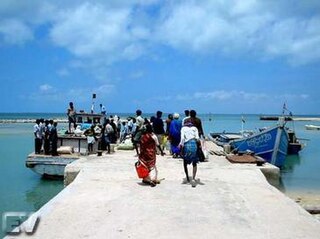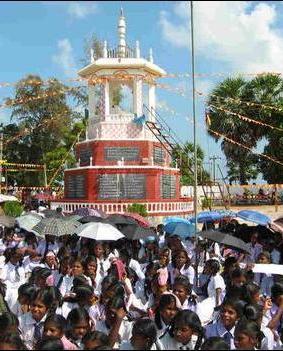
The Sri Lankan Civil War was a civil war fought in Sri Lanka from 1983 to 2009. Beginning on 23 July 1983, it was an intermittent insurgency against the government by the Velupillai Prabhakaran-led Liberation Tigers of Tamil Eelam. The LTTE fought to create an independent Tamil state called Tamil Eelam in the north-east of the island, due to the continuous discrimination and violent persecution against Sri Lankan Tamils by the Sinhalese-dominated Sri Lanka government.
Tamil Makkal Viduthalai Pulikal (TMVP), previously known as the "Karuna Group", is a political party in Sri Lanka. It was formed by Karuna Amman, a former leader of the Liberation Tigers of Tamil Eelam, after he defected from the organization in 2004. Initially a paramilitary group that helped the Sri Lankan Government fight the Tamil Tigers, the TMVP was registered as a political party in 2007. Under deputy leader Pillayan, they contested their first provincial elections in 2008, winning a majority in the Eastern Provincial Council. Members of the TMVP continue to carry arms under the auspices of the Sri Lankan government, which they claim is for their own safety from the Tamil Tigers, who carry out repeated attacks against them. The group is believed to be working with the Sri Lankan Army. They have been accused of human rights violation by local and international human rights organization.
Human rights in Sri Lanka provides for fundamental rights in the country. The Sri Lanka Constitution states that every person is entitled to freedom of thought, conscience and religion, including the freedom to have or to adopt a religion or belief of his choice. And, that every person is equal before the law.
Vinayagamoorthy Muralitharan is a Sri Lankan politician and former militant. Formerly a fighter for the Tamil separatist group, the Liberation Tigers of Tamil Eelam (LTTE), for over 20 years, Muralitharan later rose to prominence after defecting from the LTTE and forming the Tamil Makkal Viduthalai Pulikal (TMVP), a breakaway faction of the LTTE.
The 1990 Batticaloa massacre, also known as the Sathurukondan massacre, was a massacre of at least 184 minority Sri Lankan Tamil refugees, including infants, from three villages in the Batticaloa District by the Sri Lankan Army on September 9, 1990. Although the government instituted two investigations, no one was ever charged.
Seyed Ali Zahir Moulana is a Sri Lankan politician, former diplomat and local government activist. He is most known for the pivotal and important role he played in bringing about an end to the Sri Lankan Civil War.
The Eastern University massacre was the arrest and subsequent mass murder of 158 minority Sri Lankan Tamil refugees who had taken refuge in the Eastern University campus close to the city Batticaloa on September 5, 1990. A witness identified Sri Lankan Army personnel as the perpetrators. The event is part of what is known amongst Sri Lankan Tamils as Black September, a series of civilian massacres. The Sri Lankan government eventually established a presidential commission of inquiry. The inquiry found evidence of illegal abductions and mass murder. It also named the responsible parties, but there is currently no evidence of any judicial follow up to the inquiry.

The Kumudini or Kumuthini boat massacre happened on 15 May 1985 when at least 23 minority Sri Lankan Tamil men, women and children on a ferry boat named Kumudini sailing from the island of Delft to the island of Nainathivu were killed by Sri Lankan Navy personnel.

On June 12, 1991, 152 minority Sri Lankan Tamil civilians were massacred by members of the Sri Lankan military in the village Kokkadichcholai near the eastern province town of Batticaloa. The Sri Lankan government instituted a presidential commission to investigate the massacre. The commission found the commanding officer negligent in controlling his troops and recommended that he be removed from office, and identified nineteen other members of the Sri Lankan military to be responsible for mass murder. In a military tribunal that followed in the presidential commission in the capital city of Colombo, all nineteen soldiers were acquitted.

Eelam War II is the name given to the second phase of armed conflict between Sri Lankan military and the separatist Liberation Tigers of Tamil Eelam. The war started after the failure of peace talks between the Premadasa government and the LTTE. This phase of the war was initiated by the LTTE who massacred almost 600 Sinhalese and Muslim police personnel after they were ordered by the Premadasa government to surrender to the LTTE. The truce was broken on June 10, 1990 when the LTTE in October expelled all the 28,000 Muslims residing in Jaffna.
The Kattankudy Mosque Massacre was the killing of over 147 Muslim men and boys on 3 August, 1990. Around 30 armed Tamil militants raided two mosques in Kattankudy where over 300 people were prostrating in Isha prayers. The Sri Lankan government, survivors, and observers accuse the Liberation Tigers of Tamil Eelam (LTTE) of committing the crime. The LTTE denied involvement and never retracted the denial.

Arunasalam Thangathurai was a Sri Lankan Tamil lawyer, politician and Member of Parliament.

The Eastern Theater of Eelam War IV, the warfare started in the Eastern province of Sri Lanka on July 21, 2006, when the LTTE cut off the water supply to the rice fields in the Mavil aru area in the eastern Trincomalee district. The government military claimed the total control of the Eastern province after capturing the Thoppigala on July 11, 2007, after nearly a year of fighting.

The 1987 Eastern Province massacres were a series of massacres of the Sinhalese population in the Eastern Province of Sri Lanka by Tamil mobs and Liberation Tigers of Tamil Eelam (LTTE) during the Sri Lankan Civil War. Though they began spontaneously, they became more organized, with the LTTE leading the violence. Over 200 Sinhalese were killed by mob and militant violence, and over 20,000 fled the Eastern Province. The violence has been described as having had the appearance of a pogrom.
The Eravur massacre was a massacre of Sri Lankan Muslims in Eravur by the Liberation Tigers of Tamil Eelam (LTTE). The LTTE denied its involvement, but eyewitnesses and observers claim it was an LTTE massacre. The casualty figure is unclear, ranging from 116 - 173.







